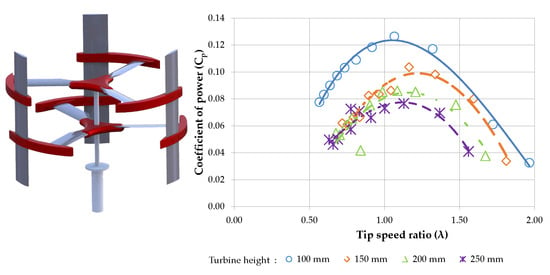Design and Testing of a Novel Building Integrated Cross Axis Wind Turbine
Abstract
:1. Introduction
2. Building Integrated Wind Turbines
3. Novel Design of a Cross Axis Wind Turbine (CAWT)
3.1. General Arrangement of the CAWT
3.2. Working Principle of the CAWT
3.3. Selection of Airfoil
3.4. Supporting Struts
4. Computational Fluid Dynamic (CFD)
5. Methods
5.1. Prototype Fabrication
5.2. Experimental Set-Up
- (a)
- CAWT mounted on building mock-up rooftop;
- (b)
- Straight-bladed VAWT mounted on the same mock-up rooftop; and
- (c)
- Variation of height (CAWT and VAWT) above the rooftop.
6. Experimental Results and Discussion
6.1. Pitch Angles of the Horizontal Blades
6.2. Variation of Height Above the Rooftop
7. Conclusions
- ➢
- The study was limited to a specific model wind turbine (CAWT) of high solidity, low power coefficient, and low Reynolds number flow regime. Therefore, it is necessary to study this new type of wind turbine in a wind tunnel with higher Reynolds number flow regime, more over the blockage ratio of the CAWT in the wind tunnel should be estimated.
- ➢
- Although the results show a better performance closer to the rooftop, it should be known that closer to the rooftop, the air flow is turbulent and the machine experiences more turbulence and as a result more fatigue. It is therefore necessary to investigate the turbulence level closer to the rooftop where the CAWT was installed and its effect on the turbine cost and its lifetime. Studies on blade fatigue should also be one of the focus areas.
- ➢
- Since the experiment were performed on a semi-open wind tunnel where the flow is not controlled, turbulent flow is expected, and the turbulence in the experimental area cannot be controlled due to the limitations of instruments and costs. The turbulence could affect the wind turbine performance; therefore, it is necessary to study the CAWT in a proper wind tunnel with higher Reynolds number flow regime and higher accuracy instruments
Acknowledgments
Author Contributions
Conflicts of Interest
References
- Bahaj, A.S.; Myers, L.; James, P.A.B. Urban energy generation: Influence of micro-wind turbine output on electricity consumption in building. Energy Build. 2007, 39, 154–165. [Google Scholar] [CrossRef]
- Beri, H.; Yao, Y. Double Multiple Stream Tube Model and Numerical Analysis of Vertical Axis Wind Turbine. Energy Power Eng. 2011, 3, 262–270. [Google Scholar] [CrossRef]
- Walker, S.L. Building mounted wind turbines and their suitability for the urban scale—A review of methods of estimating urban wind resource. Energy Build. 2011, 43, 1852–1862. [Google Scholar] [CrossRef]
- Mertens, S. Wind energy in urban areas: Concentration effects for wind turbine close to buildings. Refocus 2002, 3, 22–24. [Google Scholar] [CrossRef]
- Sunderland, K.; Conlon, M. Estimating the Yield of Micro Wind Turbines in an Urban Environment: A Methodology. In Proceedings of the 2010 45th International Universities Power Engineering Conference (UPEC), Dublin Institute of Technology ARROW@DIT, Cardiff, UK, 31 August–3 September 2010.
- Balduzzi, F.; Bianchini, A.; Carnevale, E.A.; Ferrari, L.; Magnani, S. Feasibility analysis of a Darrieus vertical-axis wind turbine installation in the rooftop of a building. Appl. Energy 2012, 97, 921–929. [Google Scholar] [CrossRef]
- Beller, C. Energy Output Estimation for a Small Wind Turbine Positioned on a Rooftop in the Urban Environment with and without a Duct; Risø National Laborator for Sustainable Energy: Roskilde, Demark, 2011. [Google Scholar]
- Padmanabhan, K.K. Study on increasing wind power in buildings using TRIZ Tool in urban areas. Energy Build. 2013, 61, 344–348. [Google Scholar] [CrossRef]
- Pope, K.; Dincer, I.; Naterer, G.F. Energy and exergy efficiency comparison of horizontal and vertical axis wind turbines. Renew. Energy 2010, 35, 2102–2113. [Google Scholar] [CrossRef]
- Islam, M.; Fartaj, A.; Carriveau, R. Analysis of the Design Parameters related to a Fixed-pitch Straight-Bladed Vertical Axis Wind Turbine. Wind Eng. 2008, 32, 491–507. [Google Scholar] [CrossRef]
- Wang, Y.; Sun, X.; Dong, X.; Zhu, B.; Huang, D.; Zheng, Z. Numerical investigation on aerodynamic performance of a novel vertical axis wind turbine with adaptive blades. Energy Convers. Manag. 2016, 108, 275–286. [Google Scholar] [CrossRef]
- Eriksson, S.; Benhoff, H.; Leijon, M. Evaluation of different turbine concept for wind power. Renew. Energy 2008, 12, 1219–1234. [Google Scholar] [CrossRef]
- Ackermann, T.; Soder, L. Wind energy technology and current status: A review. Renew. Sustain. Energy Rev. 2000, 4, 315–374. [Google Scholar] [CrossRef]
- Hyun, B.S.; Choi, D.H.; Han, J.S.; Jin, J.Y.; Roo, C.H. Performance analysis and design of vertical axis tidal stream turbine. J. Shipp. Ocean Eng. 2012, 2, 191–200. [Google Scholar]
- Johnson, G.L.; Manhattan, K.S. Wind Energy Systems. Available online: http://eece.ksu.edu/~gjohnson/Windbook.pdf (accessed on 27 September 2016).
- Dominy, R.; Lunt, P.; Bickerdyke, A.; Dominy, J. Self-starting capability of a Darrieus turbine. Proc. Inst. Mech. Eng. A J. Power Energy 2007, 221, 111–120. [Google Scholar] [CrossRef] [Green Version]
- Hill, N.; Dominy, R.; Ingram, G.; Dominy, J. Darrieus turbines: The physics of self-starting. Proc. Inst. Mech. Eng. A J. Power Energy 2009, 223, 21–29. [Google Scholar] [CrossRef]
- Bianchini, A.; Ferrari, L.; Magnani, S. Start-up Behavior of a Three-Bladed H-Darrieus VAWT: Experimental and Numerical Analysis. In Proceedings of the ASME Turbo Expo 2011 GT2011, Vancouver, BC, Canada, 6–10 June 2011.
- Kirke, B.K. Evaluation of Self-Starting Vertical Axis Wind Turbines for Stand-Alone Applications. Ph.D. Thesis, Griffith Univerisity Gold Coast Campus, School of Engineering, Brisbane, Australia, 1998. [Google Scholar]
- Worasinchai, S.; Ingram, G.L.; Dominy, R.G. The physics of H-Darrieus turbine starting behavior. J. Eng. Gas Turbines Power 2015, 138, 1–27. [Google Scholar] [CrossRef]
- Batista, N.C.; Melício, R.; Mendes, V.M.F.; Calderón, M.; Ramiro, A. On a self-start Darrieus wind turbine: Blade design and field tests. J. Renew. Sustain. Energy Rev. 2015, 52, 508–522. [Google Scholar] [CrossRef]
- Barker, J.R. Features to aid or enable self-starting of fixed pitch low solidity vertical axis wind turbines. Wind Eng. Ind. Aerodyn. 1983, 15, 369–380. [Google Scholar] [CrossRef]
- Bhutta, M.M.A.; Hayat, N.; Farooq, A.U.; Ali, Z.; Jamil, S.R.; Hussain, Z. Vertical axis wind turbine—A review of various configurations and design techniques. Renew. Sustain. Energy Rev. 2012, 16, 1926–1939. [Google Scholar] [CrossRef]
- Hau, E. Wind Turbines: Fundamentals, Technologies, Applications, Economics, 2nd ed.; Springer: Berlin, Germany, 2006. [Google Scholar]
- Stankovic, S.; Campbell, N.; Harries, A. Urban Wind Energy; Earthscan: London, UK, 2009. [Google Scholar]
- Ledo, L.; Kosasih, P.B.; Cooper, P. Roof mounting site analysis for micro-wind turbines. Renew. Energy 2011, 36, 1379–1391. [Google Scholar] [CrossRef]
- Dayan, E. Wind energy in building: Power generation in the urban environment—Where it is need most. Refocus 2006, 7, 33–38. [Google Scholar] [CrossRef]
- Cochran, B.C.; Damiani, R.R. Integrating Wind Energy into the Design of Tall Buildings—A Case Study of the Houston Discovery Tower. In Proceedings of the Wind Power 2008, Huston, TX, USA, 2–4 June 2008; pp. 1–11.
- Mertens, S. Energy yield of roof mounted wind turbine. Wind Eng. 2003, 27, 508. [Google Scholar] [CrossRef]
- Dutton, A.G.; Halliday, J.A.; Halliday, M.J. The Feasibility of Building Mounted/Integrated Wind Turbines (BUWTs): Achieving Their Potential for Carbon Emission Reductions; Final Report for Energy research Unit, Rutherford Appleton Laboratory, Science and Technology Facilities Council: Oxfordshire, UK, 4 May 2005; pp. 1–109.
- Muller, G.; Jentsch, M.; Stoddart, E. Vertical axis resistance type wind turbines for use in buildings. Renew. Energy 2009, 34, 1407–1412. [Google Scholar] [CrossRef]
- Sharpe, T.; Proven, G. Crossflex: Concept and early development of a true building integrated wind turbine. Energy Build. 2010, 42, 2365–2375. [Google Scholar] [CrossRef]
- Mertens, S.; Kuik, G.V.; van Bussel, G. Performance of an H-Darrieus in the skewed flow on a roof. J. Sol. Energy Eng. 2003, 125, 433–440. [Google Scholar] [CrossRef]
- Ferreira, C. Wind tunnel hotwire measurements, flow visualization and thrust measurement of a VAWT in skew. In Proceedings of the 44th AIAA Aerospace Sciences Meeting and Exhibit, Reno, Nevada, 9–12 January 2006.
- Bianchini, A.; Ferrara, G.; Ferrari, L.; Magnani, S. An Improved Model for the Performance Estimation of an H-Darrieus Wind Turbine in Skewed Flow. Wind Eng. 2012, 36, 667–686. [Google Scholar] [CrossRef]
- Simao Ferreira, C.J.; van Bussel, G.; van Kuik, G. An analytical methods to predict the variation in performance of a H-Darrieus in skewed flow and its experimental validation. In Proceedings of the European Wind Energy Conference, Athens, Greece, 27 February–2 March 2006.
- Chowdhury, A.M.; Akimoto, H.; Hara, Y. Comparative CFD analysis of Vertical Axis Wind Turbine in upright and tilted configureation. Renw. Energy 2016, 85, 327–337. [Google Scholar] [CrossRef]
- Dannecker, R.K.W.; Grant, A.D. Investigations of a Building Integrated Ducted Wind Turbine Module. Wind Energy 2002, 5, 53–71. [Google Scholar] [CrossRef]
- Rainbird, J.M.; Bianchini, A.; Balduzzi, F.; Peiró, J.; Graham, J.M.R.; Ferrara, G.; Ferraric, L. On the influence of virtual camber effect on airfoil polars for use in simulations of Darrieus wind turbines. Energy Convers. Manag. 2015, 106, 373–384. [Google Scholar] [CrossRef]
- Sayed, M.A.; Kandil, H.A.; Shaltot, A. Aerodynamic analysis of different wind-turbine-blade profiles using finite-volume method. Energy Convers. Manag. 2012, 2, 541–550. [Google Scholar] [CrossRef]
- Beri, H.; Yao, Y. Effect of camber on self starting of vertical axis wind turbine. Environ. Sci. Technol. 2011, 4, 302–312. [Google Scholar] [CrossRef]
- Bravo, R.; Tullis, S.; Ziada, S. Performance testing of a small scale vertical-axis wind turbine. In Proceedings of the 21st Canadian Congress of Applied Mechanics, Toronto, Canada, 3–7 June 2007; pp. 1–2.
- Hameed, M.S.; Afaq, S.K. Design and analysis of a straight-bladed vertical axis wind turbine blade using analytical and numerical techniques. Ocean Eng. 2013, 57, 248–255. [Google Scholar] [CrossRef]
- Ramkissoon, R.; Manohar, K. Increasing the Power Output of the Darrieus Vertical Axis Wind Turbine. Br. J. Appl. Sci. Technol. 2013, 3, 77–79. [Google Scholar] [CrossRef]
- Streamlining and Aerodynamics. Available online: http://www.aerospaceweb.org/question/aerodynamics/q0094b.shtml (accessed on 27 September 2016).
- ANSYS Fluent User’s Guide Released 14.0 ANSYS Inc. Available online: http://www.ansys.com (accessed on 27 September 2016).
- Menter, F.R.; Kuntz, M.; Langtry, R. Ten years of industrial experience with the SST turbulence model. In Proceedings of the Fourth International Conference on Turbulence, Heat and Mass Transfer, Redding, CT, USA, 12–17 October 2003; pp. 625–632.
- Fluent. Fluent, 5 User’s Guide 2; Fluent Inc.: Lebanon, PA, USA, 1998; pp. 8–9. [Google Scholar]
- Ferrari, L.; Bianchini, A. Critical aspects in the design of a small-size Darrieus wind turbine. In Proceedings of the World Renewable Energy Congress (WREC) XI, Abu Dhabi, UAE, 20–30 September 2010.
- Li, Y.; Calisal, S.M. Three-dimensional effects and arm effects on modeling a vertical axis tidal current turbine. Renew. Energy 2010, 35, 2325–2334. [Google Scholar] [CrossRef]
- Van Bussel, G.J.W.; Mertens, S.; Polinder, H.; Sidler, H.F.A. TURBY®concept and realisation of a small VAWT for the built environment. In Proceedings of the EAWE/EWEA Special Topic Conference: The Science of making Torque from Wind, Delft, The Netherlands, 19–21 April 2004.
- Armstrong, S.; Fiedler, A.; Tullis, S. Flow separation on a high Reynolds number, high solidity vertical axis wind turbine with straight and canted blades and canted blades with fences. Renew. Energy 2012, 41, 13–22. [Google Scholar] [CrossRef]
- Lubitz, W.D. Impact of ambient turbulence on performance of a small wind turbine. Renew. Energy 2014, 61, 69–73. [Google Scholar] [CrossRef]
- Cochran, B. The Influence of Atmospheric Turbulence on the Kinetic Energy Available during Small Wind Turbine Power Performance Testing; CEDER-CIEMAT: Soria, Spain, 2002. [Google Scholar]
- Sanderse, B. Aerodynamics of Wind Turbine Wakes: Literature Review; ECN-e-09-016; Energy Research Center of Netherland (ECN): Petten, The Netherland, 2009. [Google Scholar]
- Zanforlin, S.; Letizia, S. Improving the performance of wind turbines in urban environment by integrating the action of a diffuser with the aerodynamics of the rooftops. In Proceedings of the ATI 2015—70th Conference of the ATI Engineering Association, Roma, Italy, 9–11 September 2015; pp. 774–781.
- Ferreira, C.; Dixon, K.; Hofemann, C.; Kuik, G.V.; Gerard, V.B. The VAWT in Skew: Stereo-PIV and Vortex Modeling. In Proceedings of the 47th AIAA Aerospace Sciences Meeting Including the New Horizons Forum and Aerospace Exposition 2009, Orlando, FL, USA, 5–8 January 2009.
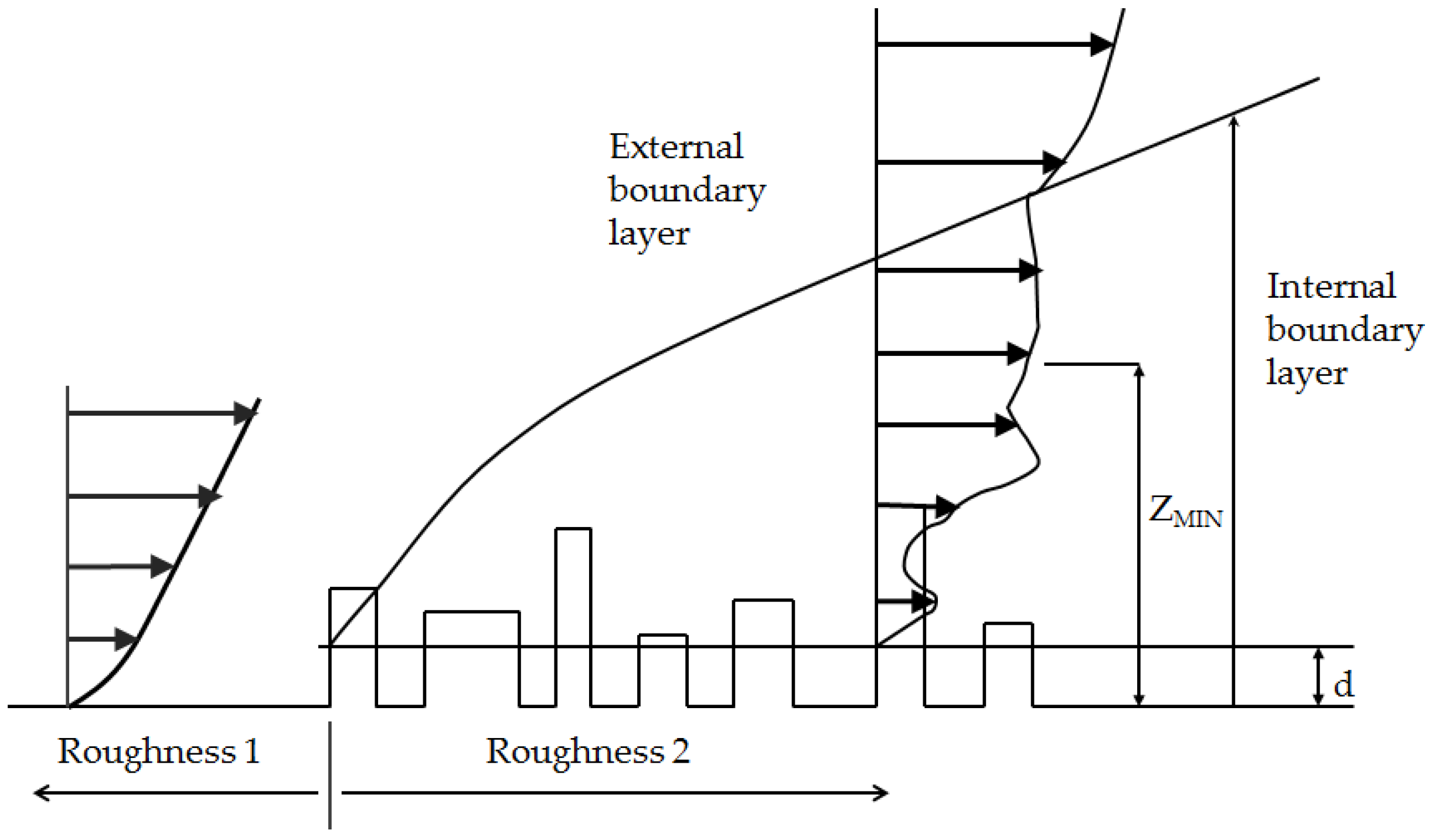
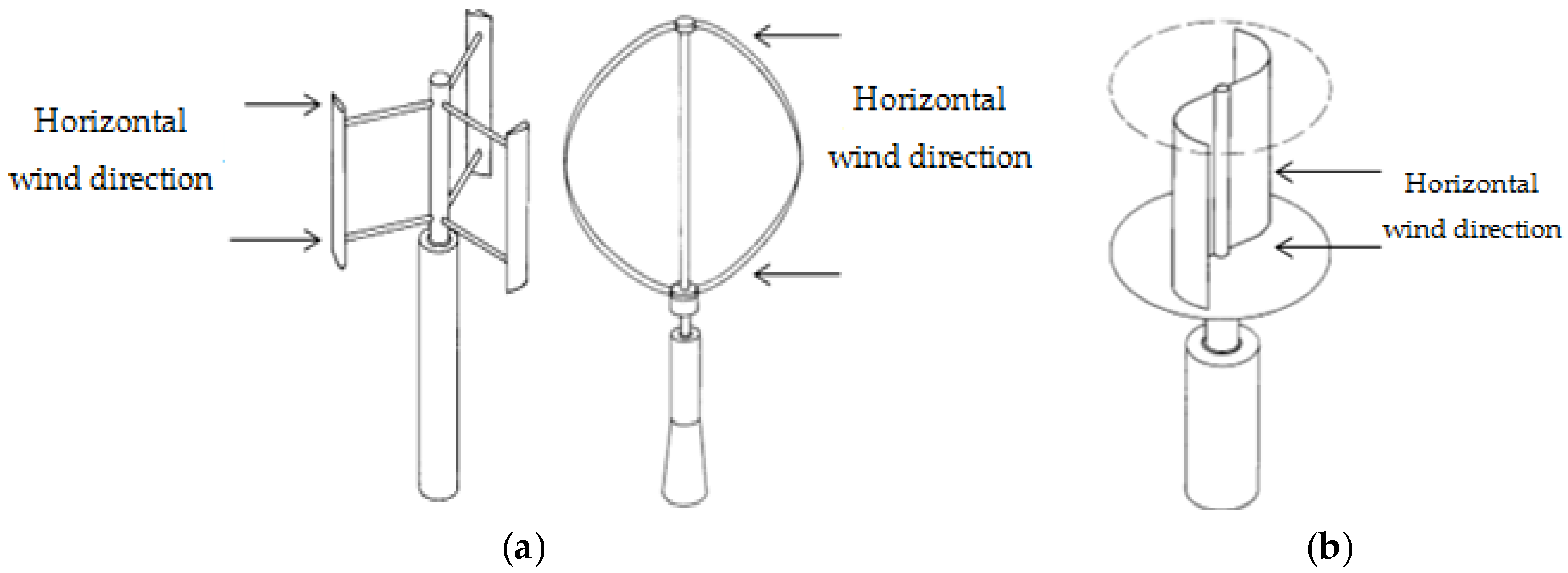



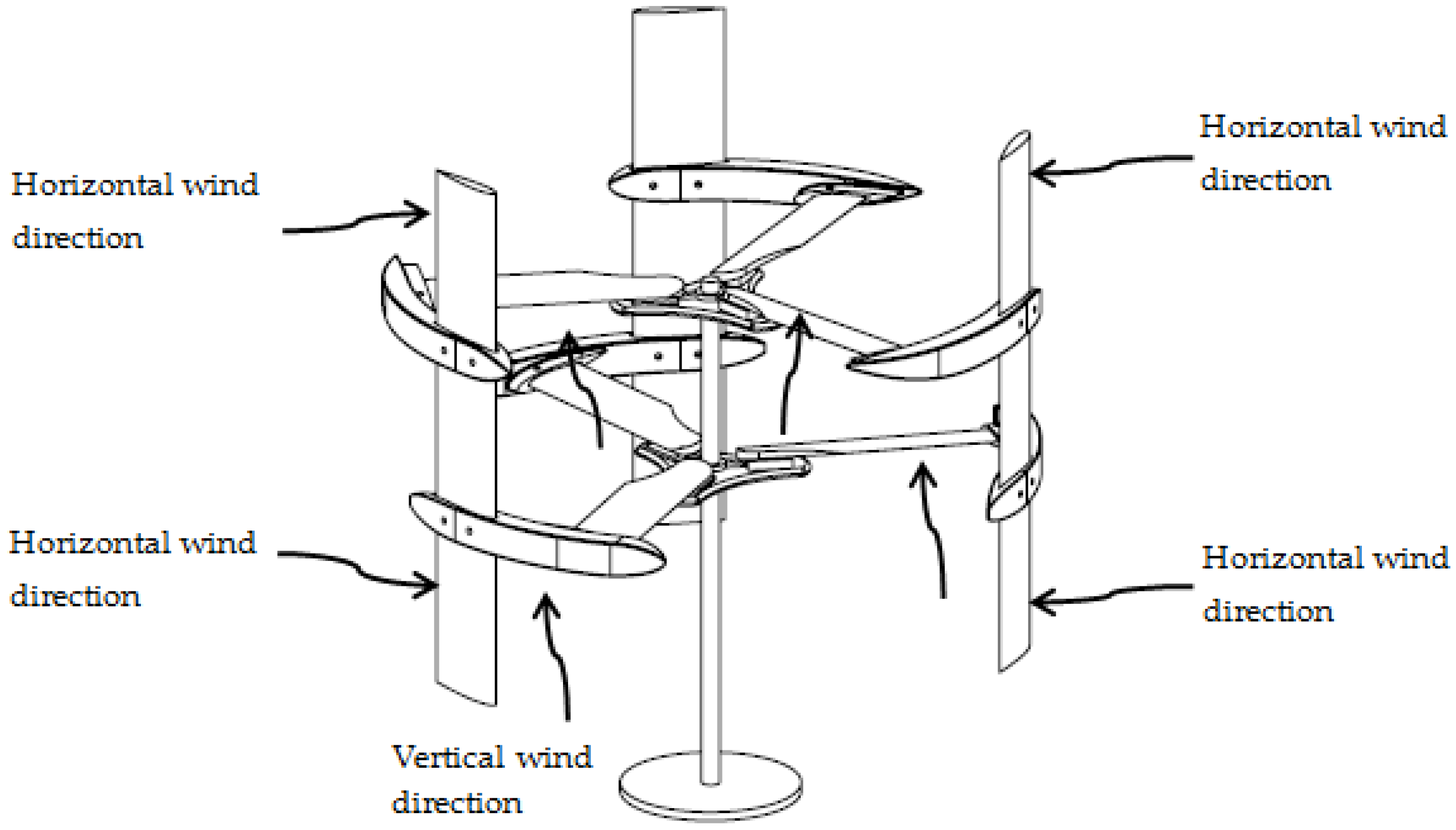
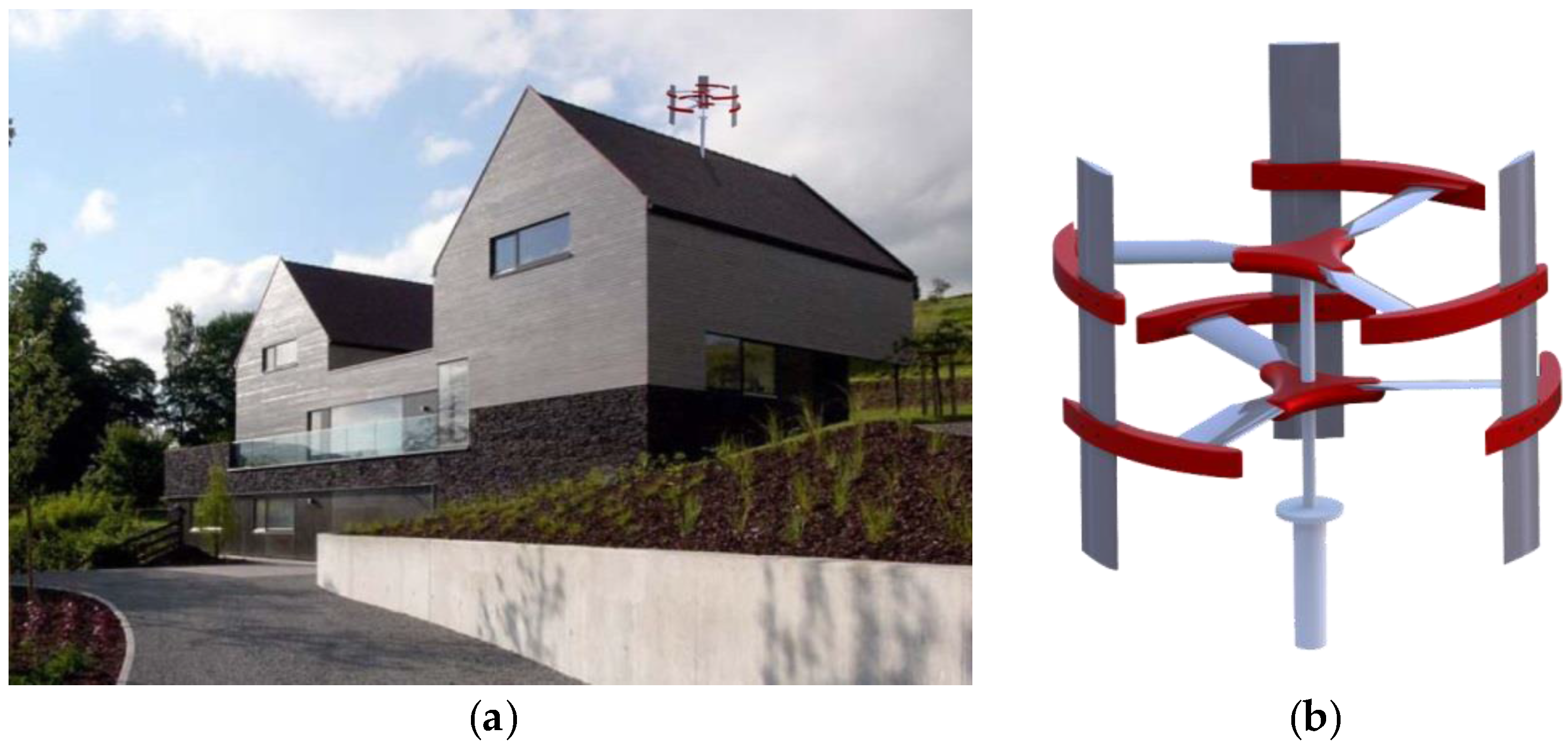
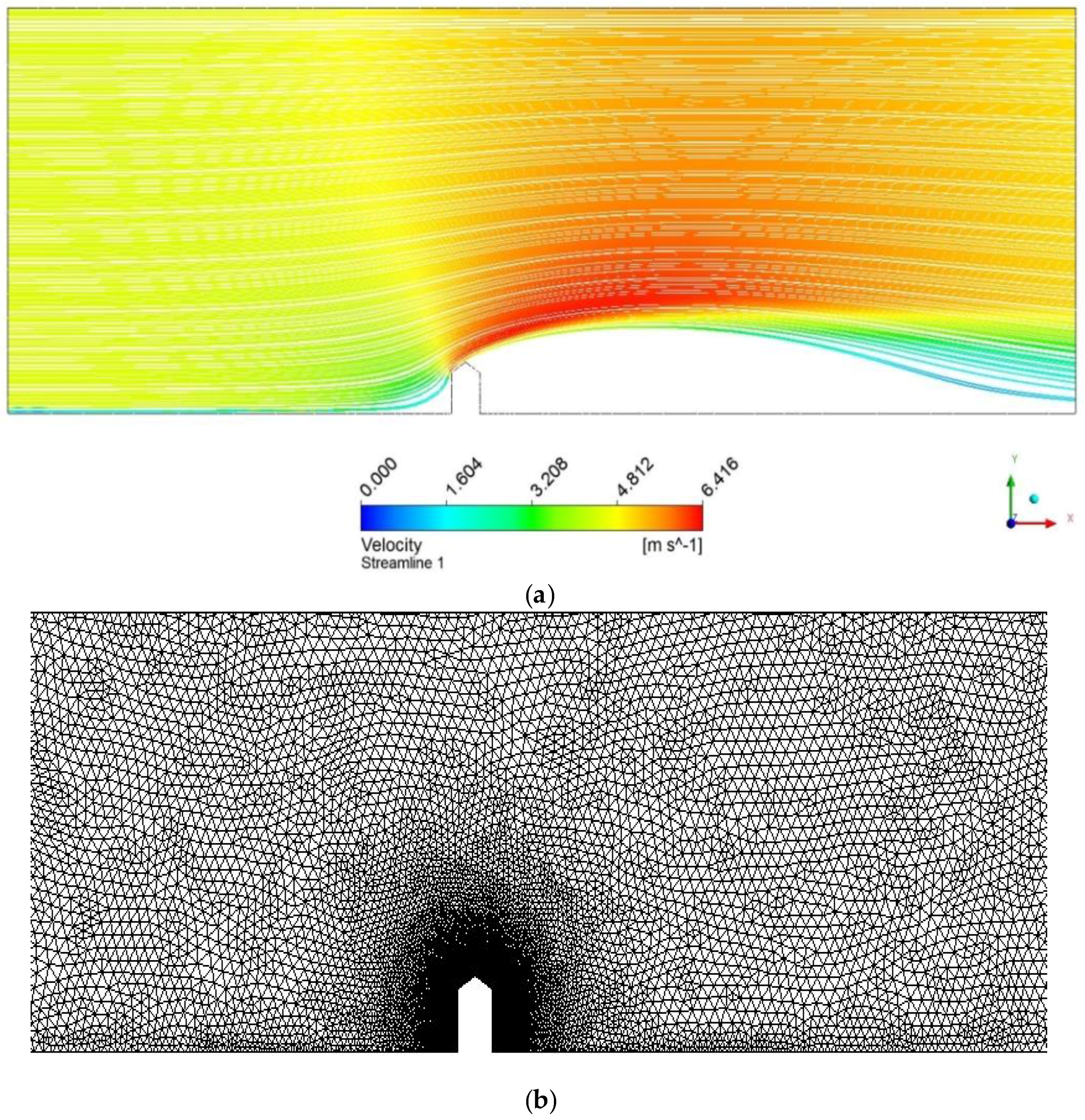

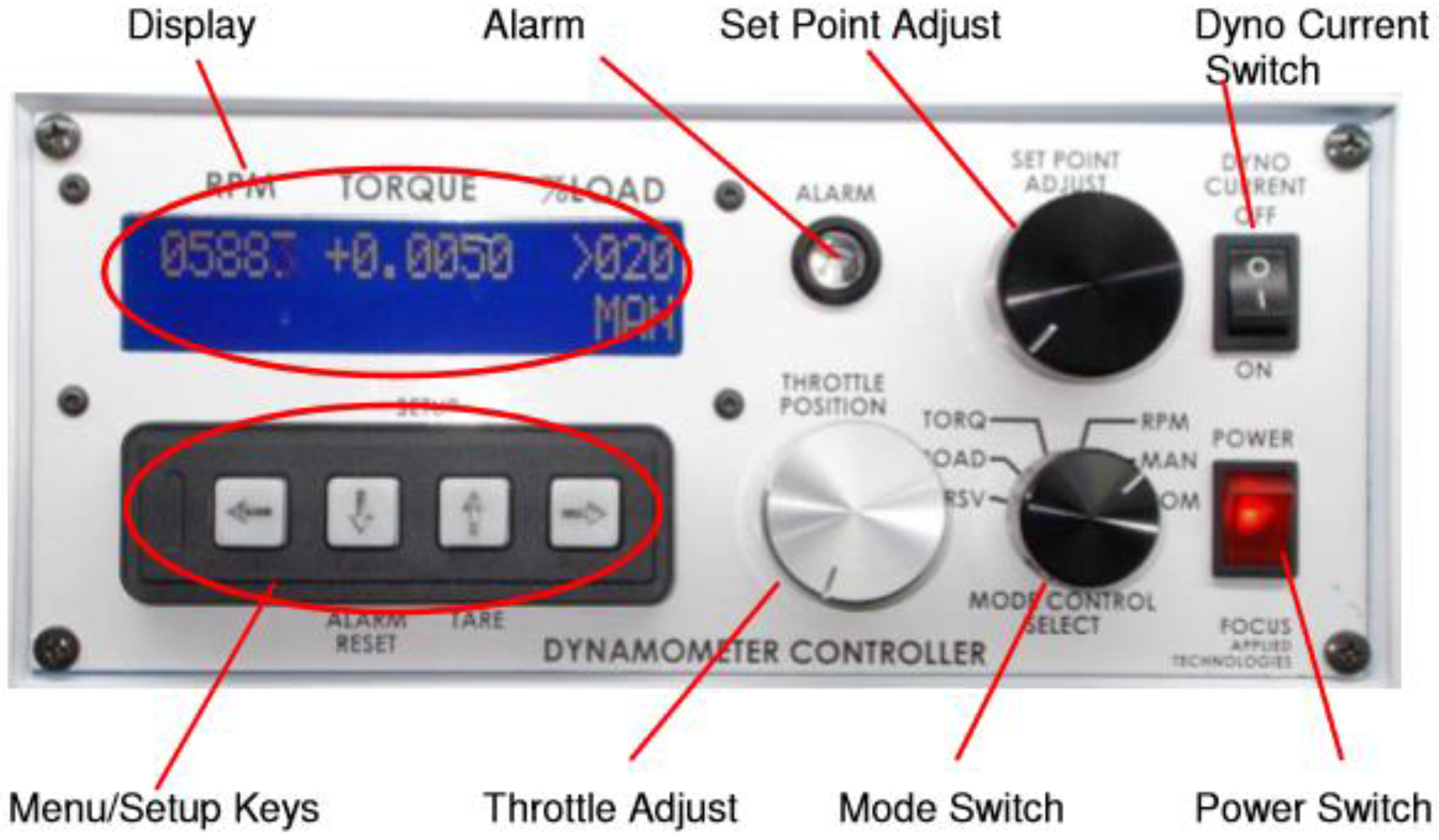
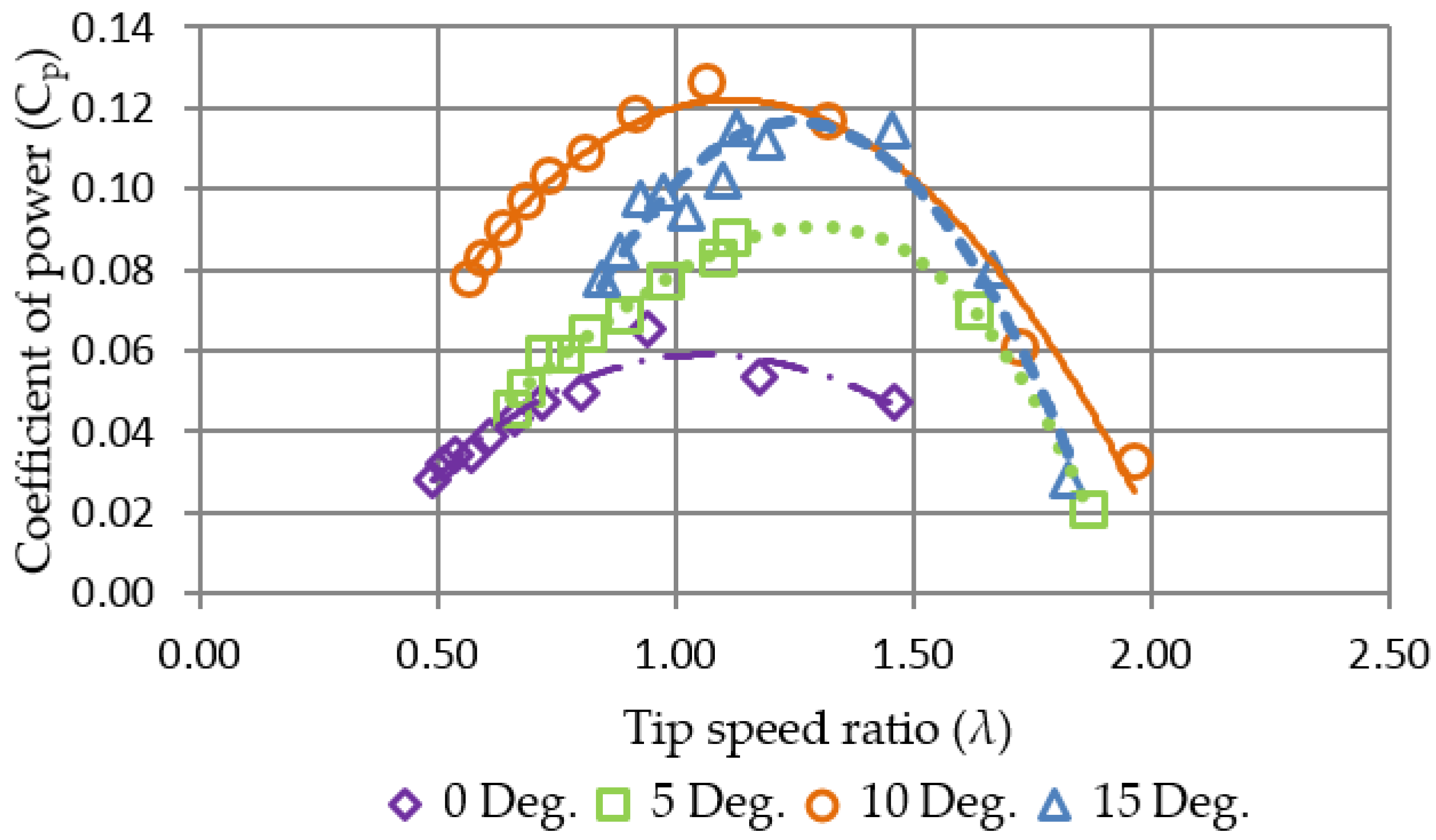


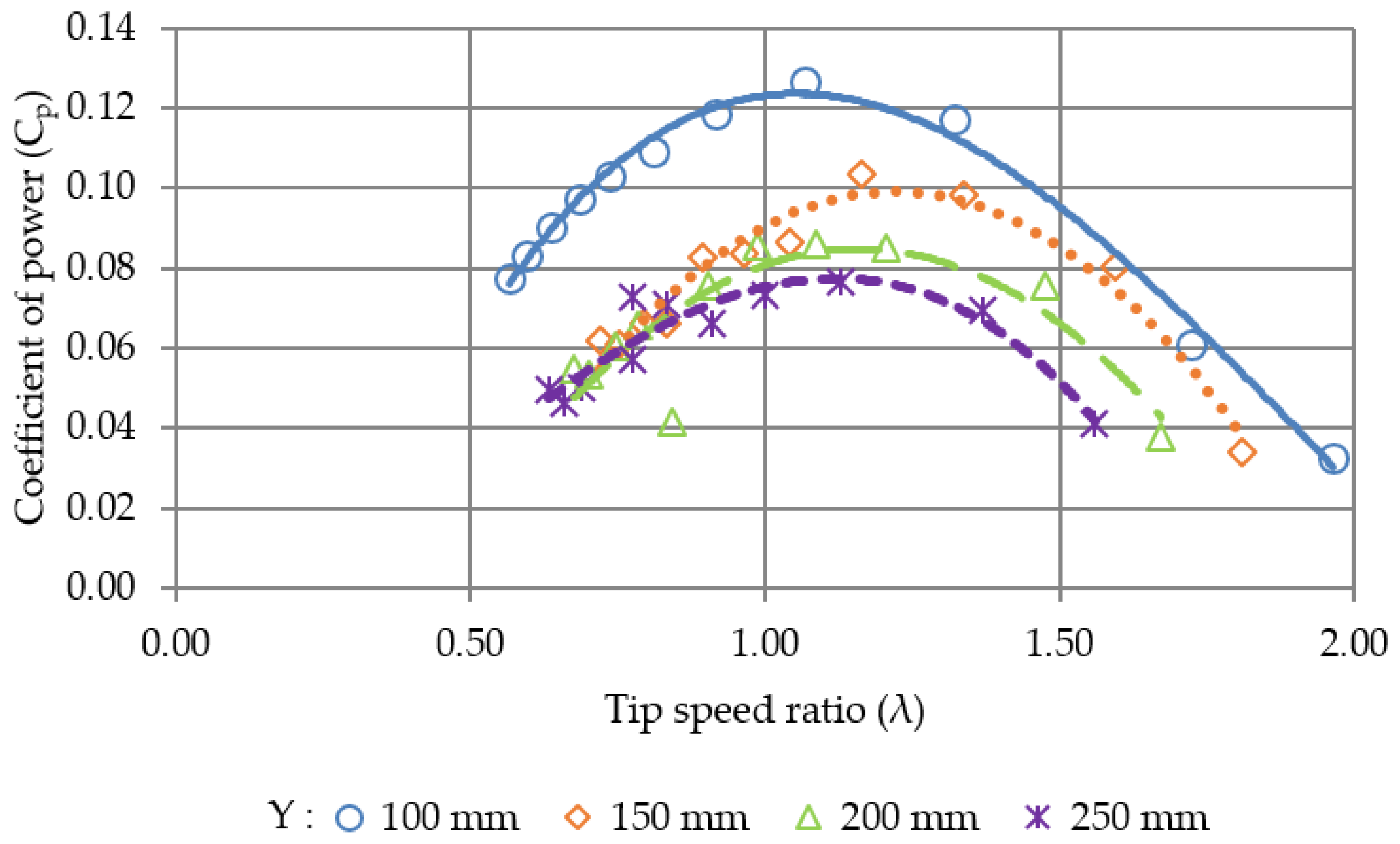
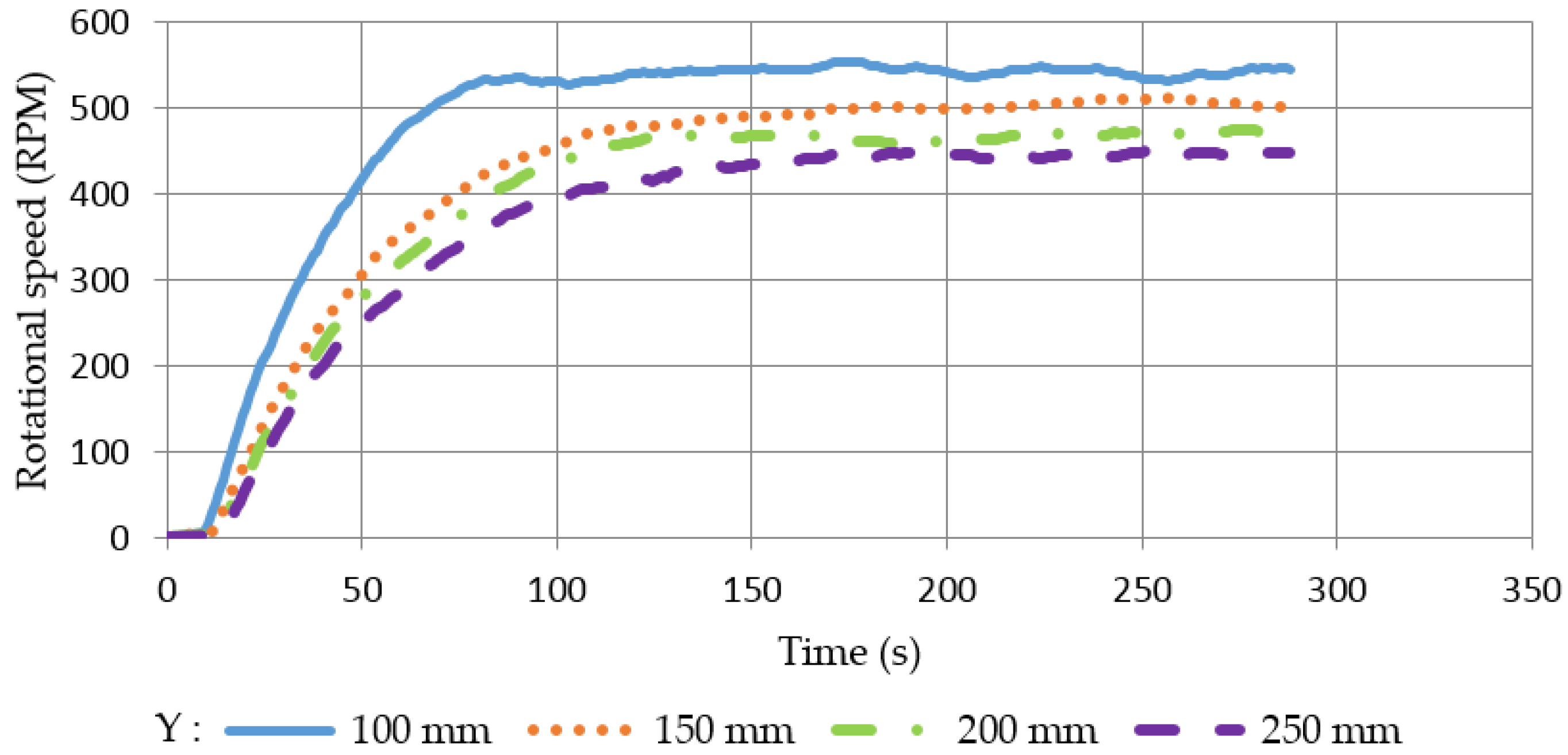
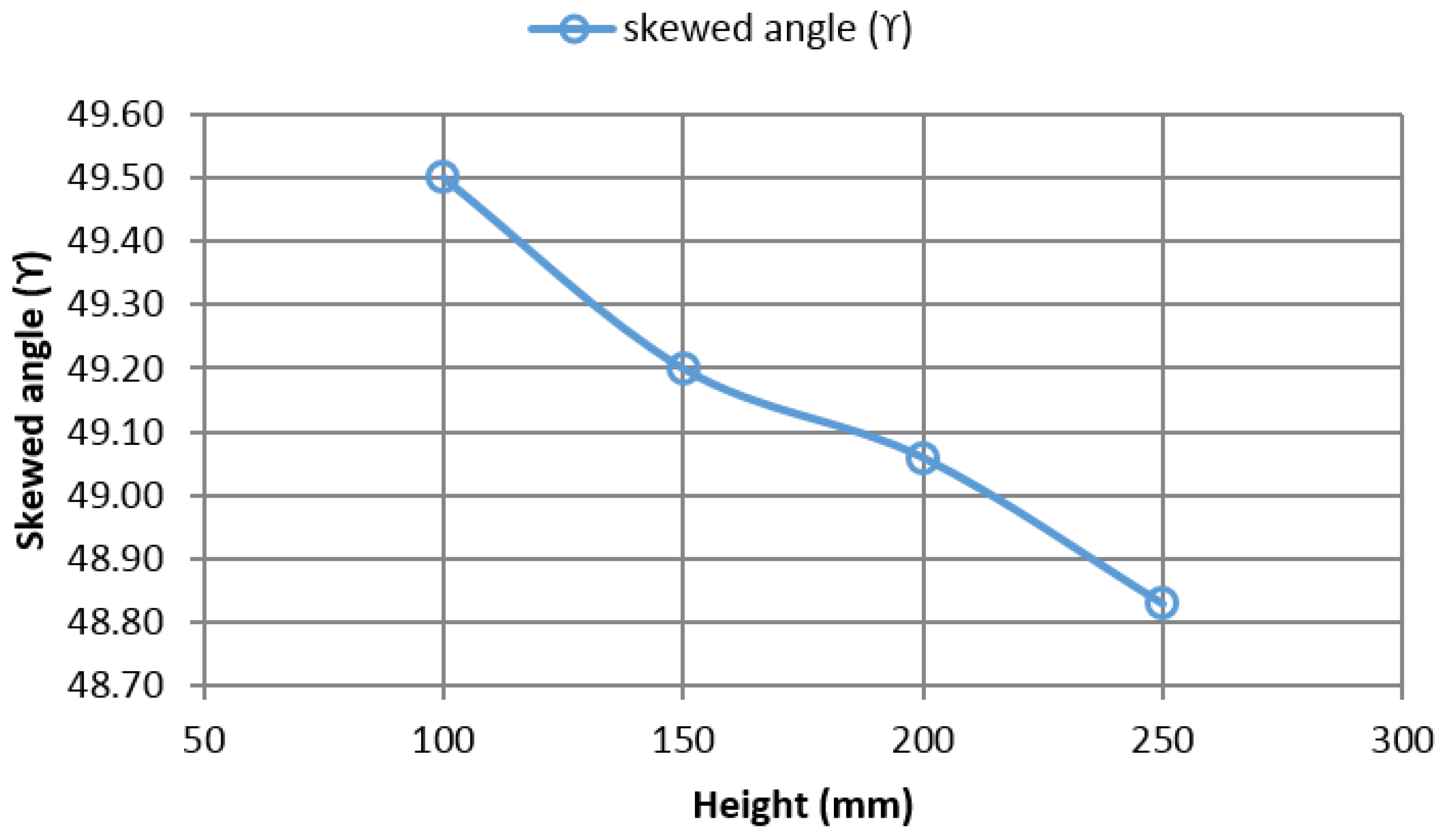
| Component | CAWT | VAWT |
|---|---|---|
| Vertical blade | Carbon fiber | Carbon fiber |
| Horizontal blade | Carbon fiber | N/A |
| Connectors | 3D printing—Acrylonitrile Butadiene Styrene (ABS) | N/A |
| Generator | 10 W | 10 W |
| Shaft | Mild steel | Mild steel |
| Hubs | 3D printing (ABS) | N/A |
| Supporting strut | Airfoil (Horizontal blades) | Flat plate |
| Parameters | CAWT | VAWT |
|---|---|---|
| Diameter of rotor, d (mm) | 350 | 350 |
| Height of vertical blade, h (mm) | 300 | 300 |
| Chord length of vertical blade, c (mm) | 50 | 50 |
| Length of horizontal blade, l (mm) of CAWT | 150 | N/A |
| Connecting strut of VAWT (mm) | N/A | 150 (flat plate: W = 25 mm, thickness = 2.03 mm) |
| Chord length of horizontal blade, c (mm) | 34 | N/A |
| Profile of aerofoil | National Advisory Committee for Aeronautics (NACA) 0015 | NACA 0015 |
| Profile of the horizontal blades | NACA 0015 | N/A |
| Pitch angle of the horizontal blade, | 10° | N/A |
| Pitch angle of the vertical blade, | 0° | 0° |
| Height (mm) | Parameter | CAWT | Straight-Bladed VAWT | Percentage of Improvement (%) |
|---|---|---|---|---|
| Y = 100 | RPM | 554 | 179 | 209 |
| Cp,max | 0.1263 | 0.0345 | 266 | |
| TSR for Cp,max | 1.1 | 0.59 | 86 | |
| Y = 150 | RPM | 512 | 189 | 171 |
| Cp,max | 0.1035 | 0.0350 | 196 | |
| TSR for Cp,max | 1.16 | 0.60 | 93 | |
| Y = 200 | RPM | 474 | 212 | 123 |
| Cp,max | 0.0859 | 0.0364 | 136 | |
| TSR for Cp,max | 1.08 | 0.51 | 112 | |
| Y = 250 | RPM | 449 | 233 | 93 |
| Cp,max | 0.0765 | 0.0448 | 71 | |
| TSR for Cp,max | 1.12 | 0.66 | 70 |
| Parameter | Height (mm) | |||
|---|---|---|---|---|
| 100 | 150 | 200 | 250 | |
| RPM | 554 | 512 | 474 | 449 |
| CP,max | 0.1263 | 0.1035 | 0.0859 | 0.0765 |
| TSR for Cp,max | 1.1 | 1.16 | 1.08 | 1.12 |
© 2017 by the authors. Licensee MDPI, Basel, Switzerland. This article is an open access article distributed under the terms and conditions of the Creative Commons Attribution (CC BY) license ( http://creativecommons.org/licenses/by/4.0/).
Share and Cite
Chong, W.T.; Gwani, M.; Tan, C.J.; Muzammil, W.K.; Poh, S.C.; Wong, K.H. Design and Testing of a Novel Building Integrated Cross Axis Wind Turbine. Appl. Sci. 2017, 7, 251. https://doi.org/10.3390/app7030251
Chong WT, Gwani M, Tan CJ, Muzammil WK, Poh SC, Wong KH. Design and Testing of a Novel Building Integrated Cross Axis Wind Turbine. Applied Sciences. 2017; 7(3):251. https://doi.org/10.3390/app7030251
Chicago/Turabian StyleChong, Wen Tong, Mohammed Gwani, Chin Joo Tan, Wan Khairul Muzammil, Sin Chew Poh, and Kok Hoe Wong. 2017. "Design and Testing of a Novel Building Integrated Cross Axis Wind Turbine" Applied Sciences 7, no. 3: 251. https://doi.org/10.3390/app7030251





